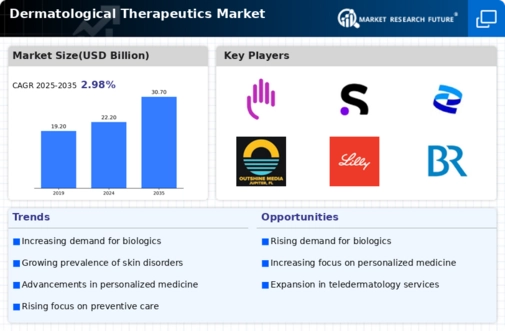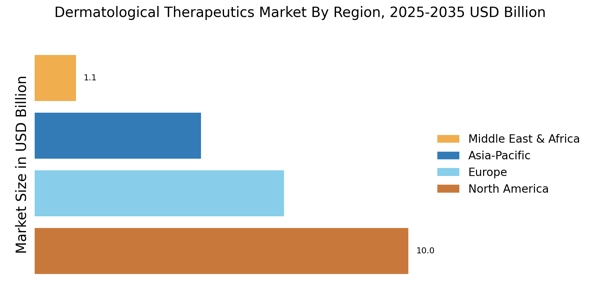Rising Awareness of Skin Health
There is a growing awareness of skin health among consumers, which is positively impacting the Dermatological Therapeutics Market. Educational campaigns and increased access to information have empowered individuals to take proactive measures regarding their skin conditions. This heightened awareness is leading to earlier diagnosis and treatment, which is crucial for effective management of skin disorders. Market Research Future indicates that consumers are increasingly seeking out dermatological products and services, resulting in a shift towards preventive care. As a result, the demand for dermatological therapeutics is expected to rise, prompting companies to enhance their offerings and focus on patient education initiatives.
Advancements in Drug Development
Technological advancements in drug development are significantly influencing the Dermatological Therapeutics Market. The emergence of novel drug delivery systems, such as microneedles and transdermal patches, enhances the efficacy of treatments while minimizing side effects. Furthermore, the integration of artificial intelligence in drug discovery accelerates the identification of potential therapeutic candidates. According to recent estimates, the dermatological therapeutics segment is projected to witness a compound annual growth rate of over 7% in the coming years. This growth is largely attributed to the introduction of targeted therapies and biologics that offer improved outcomes for patients with chronic skin conditions, thereby reshaping the market landscape.
Increasing Incidence of Skin Disorders
The rising prevalence of skin disorders, such as psoriasis, eczema, and acne, is a primary driver of the Dermatological Therapeutics Market. Recent data indicates that approximately 10% of the population suffers from some form of skin condition, leading to a heightened demand for effective treatments. This trend is further exacerbated by environmental factors, lifestyle changes, and increased exposure to pollutants. As awareness of skin health grows, patients are more likely to seek therapeutic solutions, thereby propelling market growth. The Dermatological Therapeutics Market is expected to expand as pharmaceutical companies invest in research and development to address these conditions, creating innovative therapies that cater to diverse patient needs.
Growing Demand for Aesthetic Dermatology
The increasing interest in aesthetic dermatology is driving the Dermatological Therapeutics Market. Consumers are becoming more conscious of their appearance, leading to a surge in demand for cosmetic procedures and products. Treatments such as Botox, fillers, and laser therapies are gaining popularity, contributing to market expansion. Recent statistics suggest that the aesthetic segment of dermatology is expected to grow at a rate of approximately 8% annually. This trend is fueled by the influence of social media and celebrity endorsements, which promote the importance of skin health and appearance. As a result, dermatological companies are diversifying their portfolios to include aesthetic solutions, thereby enhancing their market presence.
Regulatory Support for Dermatological Innovations
Regulatory bodies are increasingly supporting innovations in the Dermatological Therapeutics Market, facilitating the approval of new treatments. Initiatives aimed at expediting the review process for dermatological drugs are becoming more common, allowing companies to bring their products to market more swiftly. This regulatory environment encourages investment in research and development, as firms are more confident in the approval process. Recent changes in regulations have led to a notable increase in the number of new dermatological therapies approved each year. Consequently, this supportive framework is likely to stimulate growth in the market, as companies are motivated to develop cutting-edge solutions for various skin conditions.


















Leave a Comment